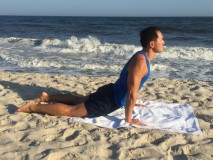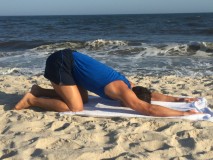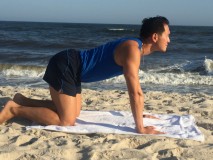Does it seem like everyone you know (maybe even you) is having back problems? Unfortunately, this is becoming one of the most common reasons that people apply for disability. Most types of back pain are caused by recreational, occupational or due to a sedentary lifestyle. One of the most common causes is weakening of the lower back muscles and imbalance with the abdominals. You can think of lower back muscles as pulleys that keep your spine straight. They pull the spine backwards like when you straighten up after tying your shoes. The abdominal muscles do the opposite, they pull you forward. When you are leaning forward while using a laptop computer, tablet, or seated at the dinner table, you will generally use the abdominals. You also lean forward if you have extra weight in the abdomen from obesity or being pregnant. Ever wonder why you see pregnant women standing up now and then, stretching up with their arms and leaning back? Now think about how much in the day you do these “abdominal” curling forward-type positions compared to the “straightening up” movements. As a result, the lower back muscles tend to wither away or in medical terms, “atrophy”. When muscles atrophy they are more susceptible to tears and sprains which can cause severe pain. Our spines are pretty much all going to be “C-shaped” within the next century!
I recommend that we all should pay more attention to our lower back and spinal muscles. Unfortunately, “abs of steel” are more coveted than “spine of steel”. By the way, strengthening your abs till you get a “six pack” but neglecting your back is a sure-fire way to end up with back pain. Strong abs will throw off the balance between the back “flexors” which are mainly the abdominal muscles, and the back “extensors” which are the back muscles.
Here are some stretches that I recommend for everyone who sits at a desk, car, train, or sofa for a combined time of more than 6 hours each day. Hold each pose for 5 seconds. If you can do 10 minutes of these exercises in the morning and the evening, you will notice your posture will be better, you will have less back/neck pain. In my office, I have a yoga mat next to my desk so that if I feel tension in the back, I can immediately stretch out and start feeling better.
Many of my favorite stretches are derived from Yoga, so if you have ever taken a Yoga class you may recognize some of them.
Cobra Pose/Child Pose– For the Cobra pose, hold your head up straight and avoid bending upward. Your eyes should be facing forward. For the Child pose, imagine someone is pulling your head gently and your spine lengthening one by one down to your tailbone.


Cat/Camel Stretch– While on all fours, imagine your belly button hitting the ceiling arching the back (Cat), hold for 5 seconds. Then, imagine your belly button trying to hit the floor (Camel)


Bird Dog/Superman Stretch– For beginners, I would pick the bird dog stretch. With one knee on the ground, lift the other leg up and the opposite arm. Hold for 5 seconds. For the Superman stretch, you will lie on the ground doing the same. If you consistently do the Superman stretch everyday for a few weeks, you may be able to lift all four limbs off at once!


Chicken Pose– This is something you can do at your desk and I recommend doing this at least every hour.Sit up straight in your chair. Raise your hands above your head. Lower them down so your forearms are now at 90 degrees with your shoulder. Turn your hands so your palms face outward as if you were trying to push the walls apart. Think about your shoulder blades coming together as if you are being folded in half, and opening up your chest and lungs. Spread your fingers out like a fan, fully extended. Tilt your head slightly up and push your neck back slightly. Drop your jaw and let it totally relax. Hold this position for a full 10 seconds, taking deep breaths. With each exhale concentrate on loosening the muscles in the neck, lower back, raising your head to the ceiling, and lengthening the spine. If you are concerned about how this might look at the office, you may want to omit the jaw lowering position.


Summer is a great time to catch up on books. Whether you read them on your patio or on the beach, I recommend these 6 books to improve your mind and your health. Here are a selection of my favorites on my bookshelf.
- The Sleep Revolution by Ariana Huffington. This book examines how most of us have lowered the priority of sleep in our lives, the consequences of inadequate sleep, and how we can be happier through improved sleep practices.
- The Miracle of Mindfulness: An Introduction to the Practice of Meditation
by Thich Nhat Hanh. This is a wonderful book about how to incorporate meditation into your life and reduce stress. Though the author is a Buddhist monk from Vietnam, his technique is universal. One of the tips I learned from this book is to stop multitasking. No one truly “multitasks” (try telling that to your boss someday!). Instead, we “toggle” between tasks, shifting our attention from one focus to another. Accordingly, we should focus on our attention on the people directly around us, and not be distracted by out electronic devices. We all know it’s dangerous to drive and text, but it’s just as wise to put the phone away when you want to spend quality time with your loved ones. Live in the moment.
- Grain Brain by Dr. David Perlmutter. Wonder why you don’t feel so great after eating a giant bowl of pasta? There is a scientific basis for this. You may not realize that “carbs” and sugars may also be affecting the way you think.
- Forks Over Knives by Gene Stone. This is the book that started an eating revolution and has many celebrity followers such as former President Bill Clinton. While I have not moved over to a completely plant-based diet, I have seen many patients with cholesterol issues improve their numbers with this lifestyle.
- Dropping Acid: The Reflux Diet Cookbook by Dr. Jamie Kaufman and Jordan Stern. A MUST for anyone with gastroesophageal reflux disease [aka GERD, heartburn, reflux, LPR (laryngopharyngeal reflux), gastritis, indigestion]. Learn what foods can cause your problems and avoid them. I was surprised to learn that not apples are created equal! Granny smith apples are very acidic and can make your heartburn unbearable but Fuji apples do not.
- Being Mortal: Medicine and What Matters in the End by Atul Gawande. We will all grow old and die. But does that mean we must suffer? This is a must-read if you have aging parents. It depicts the current crisis of the US healthcare system as it relates to end-of-life care.
In the months following the spread of Zika, I’ve seen many products marketed as being effective repellents against mosquitoes, when they truly provide little or no benefit. In my practice, I’ve also heard some “home remedies” or myths that also have no scientific basis and provide a false sense of security. Here are a list of some of these:
- Citronella bands- colorful “bracelets” with a cotton ball soaked with citronella will not protect your entire body
- Ultrasonic devices (including smartphone Apps)- mosquitoes are attracted to heat and carbon dioxide, but are not repelled by sound waves
- Eating foods such as garlic or bananas- mosquitoes are not vampires, they don’t mind if you had a slice of pizza before going outdoors
- Using a bug zapper in your yard- you will actually end up killing more beneficial insects that feed on mosquitoes!
- Citronella candles work no better than regular candles (which provide minimal benefit as most insects don’t like fire and smoke)- light them up to create a nice ambience outdoors at night, but don’t expect the swarms of mosquitoes to magically go away
- Certain blood types are more attractive to mosquitoes- mosquitoes are equal opportunity feeders, they cannot distinguish blood types when flying around.
- So-called “Mosquito plants”- this is a type of geranium sold at garden centers, which provide less mosquito protection than plants such as lavender, mint, and marigold which DO ward off many types of insects.
Here are things that have been proven to work:
- Remove standing water from your yard. Mosquito larvae can grow in small amounts of water, even as little as a bottle cap! Do a thorough cleaning of your yard and remove any standing water, such as bird baths, catch basins, or clogged gutters.
- Make sure your window and sliding door screens are intact. If there are holes, you should replace them immediately.
- Keep your skin covered when walking into wooded areas. My favorite fabric is linen because it covers your skin yet allows for good air circulation and keeps you cool. I also recommend tucking your pants into your socks to prevent the insects from crawling or flying into your pant legs.
- Mosquitos generally do not like air conditioning. Keeping your bedroom and house cool can prevent them from coming in.
- Avoid applying personal care products with fragrance. Mosquitos are attracted to scents such as perfumes. Even a strongly scented deodorant will attract them.
- Generally, most people get bitten at dawn and dusk periods, so be particularly careful if you are outdoors during these times. However there are mosquitos, including the two species that spread Zika, that feed during the daytime as well.
- Use a repellant with at least 20% DEET on your skin. Avoid products containing 100% DEET on your skin as they can be quite irritating. I recommend using a spray called Deep Woods Off! Another handy DEET-containing product is REPEL wipes. These are great if you want to be discrete about your mosquito avoidance and not create a plume of chemicals which could be irritating to people nearby. They are also very convenient for travel because, unlike the spray bottles, they are TSA compliant for carrying onboard airplanes.
- If you will be outdoor extensively (hiking outdoors, outdoor picnic, etc.) you should use Permethrin Spray on your clothing in addition to DEET on your skin. You can even spray the clothing the day before. Be sure to do this in a well ventilated area, preferably outdoors, and allow to dry. Do not spray permethrin on skin as this can cause irritation. A great idea is to spray a lightweight scarf or old T-shirt with permethrin and put it in a plastic bag so that if you do note that the mosquitos are biting, you can wrap up with it and be protected.
- Oil of lemon eucalyptus is approved by the CDC for its repellent qualities. While it is less toxic than DEET, it lasts only about 6 hours, so reapplying is often necessary for full protection.
- If you are applying sunscreen and mosquito repellant spray, you should always apply the sunscreen first and then the mosquito repellant. Doing it in reverse can cause the sunscreen to slide off and become ineffective.
Almost everyone has experienced a night of restlessness and inability to sleep called insomnia. Contrary to what the pharmaceutical companies and TV commercials tell you, most of us do not need chemicals to get us back on track. Basic lifestyle changes are more effective and healthier for you. Here are 10 tips to get a better night’s sleep.
- Unplug before you unwind. Turn off all electronic devices at least 2 hours before bedtime. Electronic devices are so bright these days that they can fool your brain into thinking it’s daylight.
- Reduce the caffeine intake. Think that second cup of coffee at 3pm isn’t affecting your sleep? Think again. Not all coffee is brewed equally. Coffee made by a certain company whose logo is a green circle with mermaid has been found to have extremely higher amounts of caffeine that you could ever possibly brew at home. Switch to decaf or cut the coffee out completely.
- Exercise. Sleep is your body’s time to repair itself. Given most of us have sedentary desk jobs, this means our body is not physically tired in most cases. Even doing an extra 7 minutes of exercise during the daytime can help you fall asleep. Just make sure that you don’t do it too late. Exercise can release hormones that temporarily make you feel awake. Wouldn’t it be great if we could all replace that afternoon coffee with some jumping jacks?
- Create a bedroom that is conducive to sleep. Don’t watch TV in the bedroom or do work in bed. If your bedroom window faces a noisy street, use a white noise machine or place a fan set on low and face it to the wall to create a low level humming sound. You can also purchase thick window curtains (black out shades). Having rugs in the bedroom can also absorb sound. Make sure the room temperature is comfortable for sleep. In general, cooler temperatures are better, around 75 degrees F.
- Wear ear plugs and eye mask. By reducing stimulation, your body will ease into sleep. Even when your eyes are closed, you can still sense light changes. Try this experiment. Close your eyes now and wave your hands up and down in front of your eyes. You will notice that you can sense the movement quite easily. Nature designed us this way to protect ourselves when we are at our most vulnerable while sleeping to enable us to run away from a tiger or other carnivorous creatures.
- Set a sleep schedule and follow it EVERY day. Our bodies like routine. When we go out of that sleep routine, we end up with altered sleep patterns. A good example when this goes wrong is jet lag. Try not to sleep in on the weekends or go to bed later than you normally would. Your body will thank you for it. You may even notice that you’ll feel much better on Monday morning.
- Minimize alcohol intake. Many cultures around the world have the tradition of having a “night cap”, or a drink of alcohol before bedtime. While it is true that small amounts of alcohol can help induce sleep, any more can actually cause disrupted sleep. During this type of sleeping pattern, you may appear asleep to others, but your mind becomes restless and when you wake up you may not feel refreshed.
- Adjust your schedule before travel. Jet lag can throw off your usual sleeping routine. Learn how to shift your schedule based on your destination.
- Avoid eating too close to bedtime. Eating stimulates production of hormones that may keep you awake. It also can cause acid reflux in susceptible people which can manifest as pain or burning in the chest.
- Meditate. People with insomnia often say they feel like their mind is still thinking about work or they feel stress. Meditation is a way to clear out those thoughts and prepare your mind to enter into a relaxing restorative state. Never meditated before? Here are some simple ways to meditate. Set aside a small pillow on the floor next to your bed, make it a habit to meditate daily before bedtime, even 5 minutes can be effective.
A story in the New York Times, titled “F.D.A. finishes food labels for how we eat now” describes how all food manufacturers will be required to put a new food information label on their products. This new label highlights the calories in a larger bold font. It also lists the number of servings per container more prominently at the top of the label.
I think these two changes are really going to help people make healthier food choices. From my own experience, I find the current food labels quite misleading. Just the other day, I looked a the label for an individually wrapped single cookie (about 3 inches in diameter) at a local coffee shop. It said the servings per container was 4, and the calories per serving was 120. Honestly, I can’t remember the last time I saw someone splitting a single cookie into fourths! However, if you glanced quickly at the label, you would assume the whole cookie was 120 calories, rather than the actual 480 calories! I have also seen food products labeling the serving size with amounts like “3 Oz.” which unless you’re a nutritionist may not be relevant to your concept of portion size. Not coincidentally, these deceptive serving sizes usually appear on “unhealthy” foods as a way to make you think you are eating a low calorie item.
For the average person with a 2000 calorie per day budget, the goal is to keep snacks at below 150 calories per serving. The snack should also have low amounts of saturated fat, cholesterol and no trans fat. Reading food labels and comparing them when you go shopping is very important to maintaining good health. I’m quite pleased at the efforts of the FDA to keep people informed about what is in their food. I think for their next step, they should consider requiring nutrition labels to be placed on alcoholic beverages. In my practice, I have seen several patients who eat relatively healthy but they pack on the weight due to the calories from ingested alcohol. Beer is the classic example. While some beers are below 100 calories, others can be as high as 350 calories (especially for the India Pale Ales, which are quite trendy right now). To put that into perspective, a can of soda is about 140-160 calories. While the beer does not taste sweet, it contains calories from the carbohydrate content and alcohol. Imagine if you had 2 of these beers, that would be an additional 700 calories! With a 2000 calorie budget per day, that would be almost what you should get from a single meal! Currently, there are few sites that have calories for alcohol and spirits. I recommend Myfitnesspal.com as they have a very extensive list of foods and beverages where you can even find specific types. For example, if you are looking for a certain brand of yogurt, it has the brand and even the specific flavor. You can also track your calories with the App for your smartphone.








